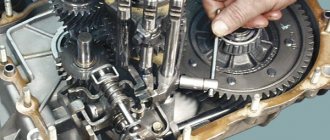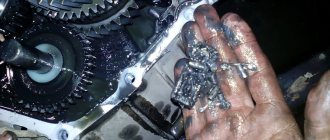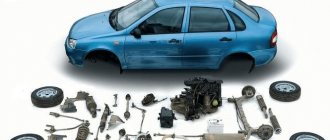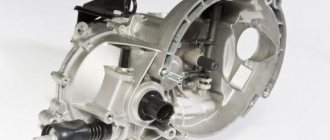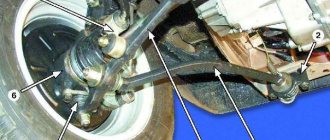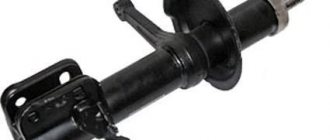Every car owner is careful about his car. It is imperative to monitor the operation of many mechanisms, and in particular the transmission. The VAZ 2109 gearbox is very durable and unpretentious in its maintenance, but still, there are some subtleties that need to be taken into account when working with it. The VAZ 21099 gearbox is a mechanical system that performs its actions with the participation of the clutch pedal. Assembling and disassembling this mechanism can be done independently, but you need to have some skills in order not to cause damage.
Checkpoint diagram
Designations
The VAZ 2108 gearbox is practically no different from the subsequent model. The repaired system does not make unnecessary noise, all switchings are smooth, the car drives without jerking, at the required speed.
The main thing that is needed is to constantly monitor its condition, control work processes and not subject it to strong stress. The VAZ 2108 gearbox is reliable, as well as low maintenance costs, since Russian parts are much more affordable than foreign ones.
Malfunctions and their elimination
Gearbox repair largely depends on the nature and type of fault. There are several options for the breakdown of this unit, in each of which appropriate actions should be taken to eliminate them.
| Malfunction | Possible reasons | What do we have to do |
| There is noise in the gearbox |
|
|
| Gears are difficult to shift |
|
|
| Spontaneous gear disengagement occurs |
|
|
| Gears are switched on with noise and crackling |
|
|
| There is an oil leak from the gearbox |
|
|
In most cases, problems with the gearbox are eliminated by dismantling and disassembling it. Do not take on this type of work without the proper skills and experience.
Useful tips
It is extremely important to monitor the serviceability of the gearbox, and if signs of breakdown are detected, fix them immediately. Do it yourself or with the help of a car service - this is your personal decision.
When operating a car in city conditions, you have to change gears more often. Therefore, it is recommended to use motor oil here. This ensures that the synchronizers remain effective longer. Transmission oil is better suited for highways, increasing the life of bearings and gears, although the synchronizer lasts less.
VAZ 2109 gearbox device
Gearbox VAZ 2109 - right view: 1 - clutch cable bracket, 2 - oil level indicator (dipstick), 3 - clutch housing, 4 - clutch release fork, 5 - input shaft of the VAZ 2109 gearbox, 6 - clutch release bearing, 7 — wheel drive shaft oil seal, 8 — protective cover of the gear shift mechanism rod, 9 — rear support of the power unit, 10 — speedometer drive.
Backstage
If the gearbox on a VAZ-2109 is ringing, don’t be upset. All owners of "nines" have this problem. Moreover, the rocker rings both on “killed” and on relatively fresh cars. The AvtoVAZ representative office itself is aware of this defect. And vibration occurs due to the incorrect location of the support points of the internal combustion engine and the gearbox. As a result, the nodes vibrate, and the ringing is transmitted to all other parts, including the slide. Some solve this problem by installing an o-ring in the rocker area, others get used to it and drive like that, with a ringing sound.
Removing the VAZ 2109 gearbox
First of all, you need to remove the mudguard and engine crankcase protection (if installed).
drain the oil from the box, remove the drive nuts and wheels. If removal takes place in a pit, it is necessary to jack up and hang the front part of the car on trestles or other reliable stands. Be sure to disconnect the battery terminals. The next order is:
– remove the clutch cable
Car history
Towards the end of the 1980s, AVTOVAZ decided to fill the empty niche of comfortable and versatile family models with the VAZ-2109 car. The fact that the debut domestic mass-produced front-wheel drive car appeared at the Volga Automobile Plant was a significant event not only for the Volga residents, but also for the entire Soviet automobile industry.
It’s a little symbolic, but the start of production of the G8 coincided with a significant event that was celebrated in the fall of 1984 - the 60th anniversary of the automobile industry of the Union of Soviet Socialist Republics. After two years, the original assembly line of the car plant in Togliatti produced a pilot batch of 159 Nine models.
The new version of the “chisel” inherited all the technical innovations from the older model and was able to instantly gain the respect of car lovers. Among all the points, the most important was the “rational” number of doors. However, despite this, a three-door version entered mass production. The logical question arises, why?
Because in a state where personal transport was considered a luxury, and happy car owners felt the transport difficulties of their relatives and friends, the standard 3-volume sedan version was more suitable to the needs of drivers. For a long time, all Soviet mass-produced cars were produced in just such a body.
More productive station wagons, which were produced in small quantities, began to be sold only towards the end of the 1960s, and they were considered in great short supply. There was not a word about other versions of the body: directors of automobile enterprises did not even risk conducting experiments, objectively believing that these programs would not be positively received “at the top.”
Appearance
From the outside, the VAZ-2109 is an evolution of the Soviet car. Here you can notice the transition to rectangular body lines, which are clearly distinguished by the bow headlights, which are shaped like a trapezoid, as well as a flat-shaped radiator grille and a slightly inclined hood. It was decided to place the turn signal lights on the long front fenders.
After some time, hydraulic headlight range control began to be installed on all “nines”, and some vehicles had a brush headlight cleaner. In 1989, the debut restyling of the “nine” exterior took place, which consisted of a transition from small front wings to longer ones. The most dubious component in the exterior of the G8 and VAZ-2109 was the so-called nasal mask.
It was a fairly complex type of body part, which was adjacent to the hood and wings installed in front. The combined mask area had a beak that protruded forward of the radiator trim. Block headlights were installed on the sides of this unusual structure. Such a pile of elements reduced the already slight elegance of the Soviet car, and the clear lines connecting the cladding to the wings looked unpleasant.
We decided to use only a solid wing, without any “tricks,” which improved the appearance of the VAZ 2109. After this, they installed a new grille, which had two longitudinal stripes in a large frame. After some time, they began to use a new version, consisting of 3 massive stripes, devoid of any frame.
VAZ-2109 with an updated radiator grille
The side part has the same straight lines of doors and roof, wheel arches and average ground clearance. “Nine” is very similar to its predecessor, the VAZ-2108, which was nicknamed “chisel”. The Soviet hatchback has the same nose shape. Unusually large doors and a thick central pillar add “sporty features” to the model.
On the “nine”, the width of the doors installed in front was reduced from 1,264 to 1,025 millimeters. Thanks to this, the design team was able to incorporate rear doors into the side of the body, the width of which is 885 millimeters. The rectangular rear lights are limited by the line of the luggage compartment lid, which also has a sharp transition at an angle to the roof.
The fifth door received a rear window with a wiper, and the bumpers, along with the side skirts, were made of black plastic (there is a similar bumper in front). The design of the VAZ 2109 has a certain swiftness of lines, but it is very far from a sports car.
Here the developers placed great emphasis on the more practical aspects of the vehicle. When 1987 arrived, the new model mastered the production of plastic gas tanks, which were much lighter and easier to assemble than others. VAZ-2108 and VAZ-2109 already had gas tanks made of steel and plastic.
It is worth admitting that after a while they decided to abandon the production of plastic tanks, as there were problems with the permeability of gasoline vapors.
Let's sum it up
After getting acquainted with the Soviet hatchback VAZ 2109, conflicting feelings remain. On the one hand, this is a car that boldly stepped into the future, because previously there were only rear-wheel drive models, but on the other, the quality of the Soviet automobile industry is lame in many respects and is significantly inferior to foreign cars.
However, among other things, the car is ideal for beginners who are just learning to drive, since the car can be purchased for a “mundane” price tag. On top of that, hatchback parts can be found everywhere and they are not that expensive, which is a definite plus. You can carry out repairs yourself in your garage, which also simplifies a lot.
The car looks quite controversial, so it has both supporters and opponents of its exterior. It is clear that there is not much free space inside, especially for rear passengers, and the luggage compartment volume clearly leaves room for improvement.
Also, the quality of the materials and plastic used for finishing is very poor, “crickets” can be heard everywhere and gaps between the panels are visible. The seats themselves are not the most comfortable, so during long trips you may feel tired. Based on crash tests, the hatchback is a dangerous car.
The car clearly lacks power, so you almost always have to turn off the engine of the VAZ 2109. But do not forget that the car is many years old and at its age it was very popular in the Soviet Union, as there were queues for it.
Yes, the model did not receive air conditioning, hydraulic power steering, etc., but tuning enthusiasts can upgrade and create a car to suit their preferences for fairly reasonable money, making the car a unique vehicle. “Chisel” will forever remain in the memory and hearts of those who owned it, despite frequent breakdowns and low levels of comfort.

